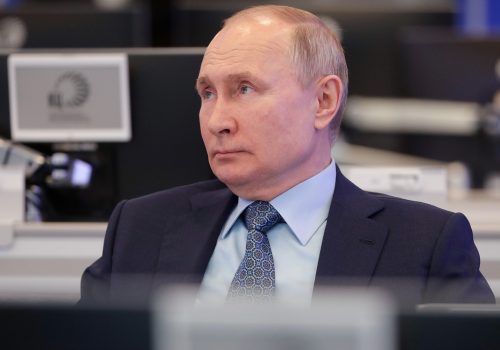Russia and China: Partners in Dedollarization
As the Winter Olympics commenced in Beijing, President Putin visited his Chinese counterpart and the two released a joint statement endorsing Russia’s position on NATO expansion. With tensions escalating along Ukraine’s borders, a potential Sino-Russian security alignment is worrying Western policymakers. However, those concerned about military cooperation should be careful to not overlook China’s increasing convergence of interests with Russia on another front – finance and dedollarization.
Dedollarization emerged as a priority for Russia in 2014 in response to the imposition of Western sanctions following the annexation of Crimea that limited the ability of state firms and banks to raise financing in Western markets. China also began seeing value in this initiative after the onset of the US-China trade war in 2018 and the use of punitive financial measures by the US.
Moscow has since made progress in reducing its reliance on the dollar. Long-term success however will depend on how Russia navigates through two new challenges: (1) increasing reliance on the euro and thus greater exposure to EU sanctions; and (2) converting euros to rubles while the dollar dominates the international currency markets. Although Beijing has broadly supported these efforts so far, it remains to be seen how much farther it will be willing to follow Moscow’s lead on dedollarization.
Dedollarization: Why and How?
Moscow found an early partner in Beijing to support its dedollarization effort as part of their expanding economic cooperation. Chinese Premier Li Keqiang signed 38 agreements on a visit to Moscow in 2014 deepening cooperation on energy and establishing a three-year currency swap deal worth 150 billion yuan (about $24.5 billion). This deal was renewed for another three years in 2017.
Russia and China shifted further away from using the dollar in bilateral trade in 2018 following the US imposition of heavy tariffs on Chinese goods and the onset of the US-China trade war. While Moscow had previously spearheaded the dedollarization initiative, Beijing quickly modeled Russia’s strategy when it perceived its own risk to punitive US financial measures. This made way for a 2019 agreement to replace the dollar with national currencies in international settlements between them. Such financial coordination helped Russia reduce its reliance on the greenback in trade. While 80% of Russia’s total exports were denominated in US dollars in 2013, only a little over half of its total exports today are settled in dollars. Most of the decrease was absorbed by its trade with China.
Apart from dedollarizing bilateral trade with China, Russia has begun replacing its dollar reserves with yuans and euros. Between 2013 and 2020, the Russian central bank halved its dollar-denominated reserves. In 2021, it revealed plans to completely ditch all dollar assets from its sovereign wealth fund and increase holdings in euros, yuan, and gold instead, thus acquiring a quarter of the world’s yuan reserves.
It is no wonder Putin acknowledged the importance of the two countries’ joint efforts in “consistently expanding settlements in national currencies and creating mechanisms to offset the negative impact of unilateral sanctions” in his piece in Xinhua earlier in February.
New Currencies, New Challenges
This partnership is nevertheless unequal, with Russia taking the lead on finding alternatives to the dollar. While only 23% of Russian exports to China were settled in the dollar in 2020, 60% of Chinese exports to Russia were still denominated in the dollar. Moreover, while Russia announced plans to establish a new international payments system with China in 2019 that would operate as an alternative to the US-dominated SWIFT, Beijing is yet to fully commit. It hasn’t encouraged Chinese banks to join the Russian system (“Sisteme Peredachi Finansovykh Soobshchenii” or SPFS), and at the moment, the Bank of China is the system’s sole Chinese member.
Even if Russia and China were to significantly reduce their reliance on the dollar, new currencies will present a new set of challenges; Putin has acknowledged just as much. Moving forward, dedollarization efforts will face two additional challenges. First, as the graph above shows, the euro unseated the dollar to become the dominant currency in bilateral trade. While using the euro decreases Russia’s exposure to US sanctions, it does not shield the Russian economy from EU sanctions. Currently, the EU imposes 150 sanctions on entities and individuals in Russia and has declared its intent to impose more if Russia continues its aggression in Ukraine. Dedollarization will not automatically sanction-proof the economy.
Second, given the Dollar’s continued primacy as the medium of exchange in international currency markets, selling euros in exchange for rubles is likely to be difficult without going through the dollar, as Iran learned a few years ago. Unless the countries can expand currency swap agreements between themselves and with other countries or develop alternatives like a central bank digital currency (CBDC) that bypasses the dollar, this indirect involvement of the greenback blunts the force of dedollarization.
It will nevertheless take some time for such a CBDC to challenge the role of the dollar in international payments. Beijing and Moscow will also struggle to convince other countries to replace the dollar with a more volatile ruble or RMB. Shares of Russian and Chinese currencies in international transactions reflect this reality. As of December 2021, the share of Chinese RMB in international payments was only 2.7%, behind the US dollar (40.5%), Euro (36.7%), and British pound (5.89%). The share of the Russian ruble was only 0.21%.
The Path Moving Forward
As the two countries plan to increase bilateral trade in the short term, it is more important than ever that the United States and European Union coordinate their sanctions policy towards Russia. Continued transatlantic coordination will limit the benefits of shifting farther away from the dollar towards the euro, and preserve the potency of financial instruments in the US toolkit. Even if Russia dedollarizes its trade with China and replaces dollar reserves with other currencies, it will find it difficult to sanction-proof its economy – its overarching objective.
Although Russia and China have managed to cooperate on trade dedollarization, misalignment of their objectives is likely to slow further dedollarization. Russia is actively introducing new initiatives to dedollarize trade and transactions but China is reluctant on both counts. With three-fifths of Chinese exports to Russia still dollar-dominated and Chinese banks still not rushing to join SPFS, it remains to be seen how much farther China will be willing to follow Russia’s dedollarization agenda.
Mrugank Bhusari is a Program Assistant with the Atlantic Council’s GeoEconomics Center. @BhusariMrugank
Maia Nikoladze is a Program Assistant with the Economic Statecraft Initiative at the Atlantic Council’s GeoEconomics Center.
Related reading

At the intersection of economics, finance, and foreign policy, the GeoEconomics Center is a translation hub with the goal of helping shape a better global economic future.
Image: Dollar Plaza Accord Exchange Rate Euro Yen Pound


